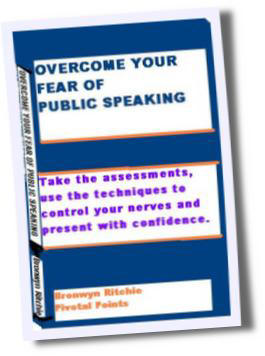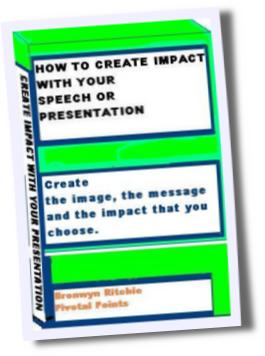|
When you stand
up to speak, you have no guarantees that your
audience will listen intently to your every word. We
all know that behind those "I'm-all-ears" looks,
your listeners' minds can wander. Think about how
much your mind has wandered during other people's
presentations!
You can't gain support, sell ideas, or push a
new initiative if people aren't listening. So, it's
your job to shatter that fixed facade, grab your
listeners' attention, and hold on tight. You have to
earn their attention right from the beginning of
your talk. Here's how:
Plan. Plan your opening words carefully.
Don't stumble into your presentation with a
hackneyed "Today, I'm going to talk about..." Say
something meaningful (even bold!) that will grab the
attention of your audience immediately. Don't lead
up to it with trivialities. Think about your
audience's single biggest concern within your topic,
and speak directly to it. There are a lot of
different ways to open a talk; just make sure you
choose one that begins with substance and matters to
your listeners.
Rehearse. Stand up and deliver your opening
out loud several times prior to the talk. Make sure
you can do it comfortably and reliably. For most
people, the first words of a presentation are the
hardest. Make certain you know yours well enough so
you don't have to worry about them. By spending
extra rehearsal time on your opening, you can turn
the hardest part of your talk into the easiest.
Get ready. When the time comes to deliver
your presentation, you will want to be focused, in
control of your voice, your body language, and those
pre-presentation jitters. So, before you stand up to
speak, practice some "stage fright" prevention. Use
our
tips for breathing easily to warm up. If you
have a chance to exercise or go for a walk before
your presentation, do it. It's important that your
mind and your body are ready to deliver a powerful
presentation when you arrive in the room.
Connect. Make an immediate connection with
your audience. Look 'em in the eye. Before you
begin, find a "focus person" for your opening. The
focus person should be someone who is sitting toward
the back of the room and roughly in the center.
Ideally, this should be a person who will listen
attentively and will be a friendly face for your
first sentence or two. Remember to establish your
eye focus first, then take a fresh breath, and, only
after you have a full tank of air, begin to speak.
Leap. As much as possible, jump right into
your talk. Get right to the point. Try to avoid any
long preambles or explanations. Deliver your opening
just as you've practiced it, right to your focus
person. Once you've landed your opening, the rest of
your presentation is more likely to go smoothly.
And, you will have gained the attention of the
audience right from the start of your talk.
Stop ... and go. After you deliver your
opening, pause. Let your words sink in for a second
or two. Next, link that opening to the body of your
presentation. Make sure your audience sees how your
opening leads into your first point. There's nothing
worse than gearing everyone up with a great opener,
only to let everyone down by wandering off on other
track.
And they're off... You delivered your opening
and linked it to your first point. You've set the
stage for your success. You've got momentum heading
into the body of your presentation. You're out of
the gate and rounding the bend. Just make sure to
keep your head up, eyes focused on your audience,
and charge ahead with an energetic and effective
presentation.
Copyright © 2004 E.C.G., Inc. All rights reserved.
May not be reproduced, distributed, transmitted,
displayed, published, or broadcast for any
commercial purpose without specific written
permission. We invite you to use our articles,
without modification, for noncommercial purposes,
provided there is adequate attribution and a link
back to our web site (we only request that you
inform us of any such use). In addition, we welcome
appropriate links to our site from other sites
|


